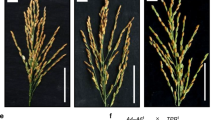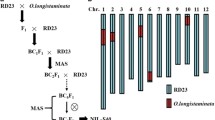Abstract
A chromosomal region containing a hybrid sterility locus, S 1, from Oryza glaberrima, located on the short arm of chromosome 6, was investigated in 15 BC7F1 and one BC3F2 populations. As a gamete eliminator, S 1 induced both male and female gamete abortion and responded to typical, spherical, or empty pollen abortion when it was heterozygous. The gametes carrying S a1 (Oryza sativa allele in S 1) in the heterozygous S 1 locus had been eliminated in previous studies. We found here that both male and female gametes carrying the S a1 allele were killed incompletely in heterozygous (S g1 S a1 ) plants, with 26.22% female and 9.06% male gametes with the S a1 genotype remaining when the BC3F1 sterile plant produced male and female gametes, which fits with the hypothesis that the ratio of S a1 gametes of the female that were killed is higher than that of the male gametes. In addition, in sterile BC6F1 plants with the heterozygous S 1 locus, not only a majority of the female gametes carrying the S a1 allele, but also a quite number of those carrying the S g1 allele (O. glaberrima allele in S 1) could not be transmitted to their offspring. This abnormal transmission of female gametes illustrates the complexity of the reproductive isolation mechanism caused by S 1 and can not be explained by the ‘one locus, sporo-gametal interaction’ model alone. Interaction for female sterility between S 1 and two other loci on chromosomes 1 and 4 that suppress the expression of S 1 was identified. S 1 is the main reproductive isolation locus when mining favorable traits/genes from O. glaberrima due to its ubiquity between these two species, and the development of bridge parents carrying S 1 should be a useful method for overcoming or abating this obstacle between these two species. The chromosomal region of S 1 may be the hot region of genetic diversity for speciation because several hybrid sterility loci between species, subspecies, and even intra-subspecies have been identified in the same region.

Similar content being viewed by others
References
Attere A, Fatokun C (1983) Reaction of Oryza glaberrima accessions to rice yellow mottle virus. Plant Dis 67:420–421
Chen C (2006) Validation of QTLs controlling yield traits on the short arm of rice chromosome 6. MSc thesis. Chinese Academy of Agricultural Sciences, People’s Republic of China
Chen JJ, Ding JH, Ouyang YD, Du HY, Yang JY, Cheng K, Zhao J, Qiu SQ, Zhang XL, Yao JL, Liu KD, Wang L, Xu CG, Li XH, Xue YB, Xia M, Ji Q, Lu JF, Xu ML, Zhang QF (2008) A triallelic system of S5 is a major regulator of the reproductive barrier and compatibility of indica–japonica hybrids in rice. Proc Natl Acad Sci USA 105(32):11436–11441
Chen Z, Hu F, Xu P, Li J, Deng X, Zhou J, Li F, Chen S, Tao D (2009) QTL analysis for hybrid sterility and plant height in interspecific populations derived from a wild rice relative, Oryza longistaminata. Breed Sci 59:441–445
Dingkuhn M, Jones M, Johnson DE, Sow A (1998) Growth and yield potential of Oryza sativa and O. glaberrima upland rice cultivars and their interspecific progenies. Field Crops Res 57:57–69
Doi K, Yoshimura A, Iwata N (1998) RFLP mapping and QTL analysis of heading date and pollen sterility using backcross population between Oryza sativa L. and Oryza glaberrima Steud. Breed Sci 48:395–399
Doi K, Taguchi K, Yoshimura A (1999) RFLP mapping of S20 and S21 for F1 pollen semi-sterility found in backcross progeny of Oryza sativa and O. glaberrima. Rice Genet Newsl 16:65–68
Endo TR (2007) The gametocidal chromosome as a tool for chromosome manipulation in wheat. Chromosome Res 15:67–75
Friebe B, Zhang P, Nasuda S, Gill BS (2003) Characterization of a knock-out mutation at the Gc2 locus in wheat. Chromosoma 111:509–517
Heuer S, Miezan KM (2003) Assessing hybrid sterility in Oryza glaberrima × O. sativa hybrid progenies by PCR marker analysis and crossing with wide compatibility varieties. Theor Appl Genet 107:902–909
Hu FY, Xu P, Deng XN, Zhou JW, Li J, Tao DY (2006) Molecular mapping of a pollen killer gene S29(t) in Oryza glaberrima and co-linear analysis with S22 in O. glumaepatula. Euphytica 151:273–278
Ikeda R, Sokei Y, Akintayo I (2009) Seed fertility of F1 hybrids between upland rice NERICA cultivars and Oryza sativa L. or O. glaberrima Steud. Breed Sci 59:27–35
Ikehashi H, Araki H (1986) Genetics of F1 sterility in remote crosses of rice (Oryza sativa L.). In: International Rice Research Institute (ed) Rice genetics. IRRI, Manila, pp 119–130
Jones MP, Dingkuhn M, Aluko GK, Senmon M (1997a) Interspecific Oryza sativa × O. glaberrima Steud. progenies in upland rice improvement. Euphytica 92:237–246
Jones MP, Mande S, Aluko K (1997b) Diversity and potential of Oryza glaberrima Steud. in upland rice breeding. Breed Sci 47:396–398
Khush GS (1989) Multiple disease and insect resistance for increase yield stability in rice. In: International Rice Research Institute (ed) Progress in rice research. International Rice Research Institute, Manila, pp 79–92
Koide Y, Onishi K, Kanazawa A, Sano Y (2008a) Genetics of speciation in rice. In: Hirano HY, Hirai A, Sano Y, Sasaki T (eds) Rice biology in the genomics era. Biotechnology in agriculture and forestry, vol 62. Springer, Berlin, pp 247–259
Koide Y, Onishi K, Nishimoto D, Baruah AR, Kanazawa A, Sano Y (2008b) Sex-independent transmission ratio distortion system responsible for reproductive barriers between Asian and African rice species. New Phytol 179:888–900
Kubo T, Yamagata Y, Eguchi M, Yoshimura A (2008) A novel epistatic interaction at two loci causing hybrid male sterility in an inter-subspecific cross of rice (Oryza sativa L.). Genes Genet Syst 83:443–453
Li ZB (1980) A preliminary discussion about the classification of male sterile lines of rice in China. Acta Agron Sin 6(1):17–26
Li DT, Chen LM, Jiang L, Zhu SS, Zhao ZG, Liu SJ, Su N, Zhai HQ, Ikehashi H, Wan JM (2007) Fine mapping of S32(t) a new gene causing hybrid embryo sac sterility in a Chinese landrace rice (Oryza saliva L.). Theor Appl Genet 114:515–524
Li J, Xu P, Deng XN, Zhou JW, Hu FY, Wan JM, Tao DY (2008) Identification of four genes for stable hybrid sterility and an epistatic QTL from a cross between Oryza sativa and Oryza glaberrima. Euphytica 164(3):699–708
Liu HY, Xu CG, Zhang QF (2004) Male and female gamete abortions, and reduced affinity between the uniting gametes as the causes for sterility in an indica/japonica hybrid in rice. Sex Plant Reprod 17:55–62
Long YM, Zhao LF, Niu BX, Su J, Wu H, Chen YL, Zhang QY, Guo JX, Zhuang CX, Mei MT, Xia JX, Wang L, Wu HB, Liu YG (2008) Hybrid male sterility in rice controlled by interaction between divergent alleles of two adjacent genes. Proc Natl Acad Sci USA 105(48):18871–18876
Manly KF, Cudmore R H Jr, Meer JM (2001) Map Manager QTX, cross-platform software for genetic mapping. Mamm Genome 12:930–932
Mizuta Y, Harushima Y, Kurata N (2007) Mapping of a pair of reproductive barrier loci observed in a cross between Nipponbare and Kasalath. Rice Genet Newsl 23:33
Nagano H, Kawasaki S, Kishima Y, Sano Y (2000) Structural differences in the vicinity of the waxy locus among the Oryza species with the AA-genome: identification of variable regions. Theor Appl Genet 100:376–383
Oka HI (1974) Analysis of genes controlling F1 sterility in rice by the use of isogenic lines. Genetics 77:521–534
Reversat G, Destombes D (1995) Resistance to Heterodera sacchari in rice. Nematologica 41:333–334
Saitoh K, Onishi K, Mikami I, Thidar K, Sano Y (2004) Allelic diversification at the C (OsC1) locus of wild and cultivated rice: nucleotide changes associated with phenotypes. Genetics 168:997–1007
Sano Y (1983) A new gene controlling sterility in F1 hybrids of two cultivated rice species. J Hered 74:435–439
Sano Y (1986) Sterility barriers between Oryza sativa and O. glaberrima. In: International Rice Research Institute (ed) Rice genetics. International Rice Research Institute, Manila, pp 109–118
Sano Y (1990) The genic nature of gamete eliminator in rice. Genetics 125:183–191
Sano Y, Chu YE, Oka HI (1979) Genetic studies of speciation in cultivated rice. 1. Genic analysis for the F1 sterility between Oryza sativa L. and O. glaberrima Steud. Jpn J Genet 54:121–132
Silue D, Notteghem J (1991) Resistance of 99 Oryza glaberrima varieties to blast. Int Rice Res Notes 16:13–14
Taguchi K, Doi K, Yoshimura A (1999) RFLP mapping of S19, a gene for F1 pollen semi-sterility found in backcross progeny of Oryza sativa and O. glaberrima. Rice Genet Newsl 16:70–71
Tao D, Hu F, Yang Y, Zhou Y, Chen H (2002) Studies on crossability between two cultivated rice species Oryza sativa and O. glaberrima. Rice Genet Newsl 19:27–29
Tao D, Xu P, Li J, Yang YQ, Zhou JW, Hu FY, Jones MP (2003) Hybrid sterility inheritance and mapping of sterile genes among near-isogenic lines derived from interspecific hybrid between cultivated rice species Oryza sativa and O. glaberrima. Chin J Rice Sci 17(1):11–15
Wu CI, Ting CT (2004) Genes and speciation. Nat Rev Genet 5:247–257
Xu P, Tao DY, Hu FY, Zhou JW, LI J, Deng XN (2005) Cultivated rice interspecific hybridization breeding for japonica rice in Yunnan province. Chin J Rice Sci 19(1):41–46
Zhang ZS, Lu YG, Liu XD, Feng JH, Zhang GQ (2006) Cytological mechanism of pollen abortion resulting from allelic interaction of F1 pollen sterility locus in rice (Oryza sativa L.). Genetica 127:295–302
Zhao ZG, Jiang L, Zhang WW, Yu CY, Zhu SS, Xie K, Tian H, Liu LL, Ikehashi H, Wan JM (2007) Fine mapping of S31 a gene responsible for hybrid embryo-sac abortion in rice (Oryza sativa L.). Planta 226:1087–1096
Acknowledgments
This research was funded partially by grants from Ministry of Science and Technology (2006CB708207), and Yunnan Department of Science and Technology (2002C0009Z, 2003RC02, 2004PY01-21, 2006GP09, and 2006C0063M), People’s Republic of China.
Author information
Authors and Affiliations
Corresponding authors
Rights and permissions
About this article
Cite this article
Zhou, J., Xu, P., Deng, X. et al. Genetic dissection of a chromosomal region conferring hybrid sterility using multi-donors from Oryza glaberrima . Euphytica 175, 395–407 (2010). https://doi.org/10.1007/s10681-010-0188-x
Received:
Accepted:
Published:
Issue Date:
DOI: https://doi.org/10.1007/s10681-010-0188-x




